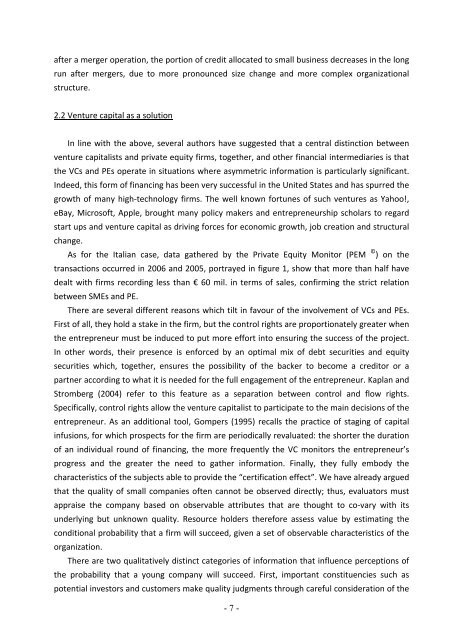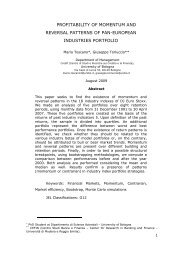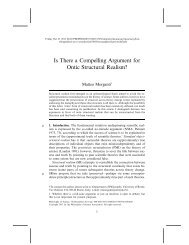Determinants and effects of Venture Capital and Private Equity ...
Determinants and effects of Venture Capital and Private Equity ...
Determinants and effects of Venture Capital and Private Equity ...
Create successful ePaper yourself
Turn your PDF publications into a flip-book with our unique Google optimized e-Paper software.
after a merger operation, the portion <strong>of</strong> credit allocated to small business decreases in the long<br />
run after mergers, due to more pronounced size change <strong>and</strong> more complex organizational<br />
structure.<br />
2.2 <strong>Venture</strong> capital as a solution<br />
In line with the above, several authors have suggested that a central distinction between<br />
venture capitalists <strong>and</strong> private equity firms, together, <strong>and</strong> other financial intermediaries is that<br />
the VCs <strong>and</strong> PEs operate in situations where asymmetric information is particularly significant.<br />
Indeed, this form <strong>of</strong> financing has been very successful in the United States <strong>and</strong> has spurred the<br />
growth <strong>of</strong> many high‐technology firms. The well known fortunes <strong>of</strong> such ventures as Yahoo!,<br />
eBay, Micros<strong>of</strong>t, Apple, brought many policy makers <strong>and</strong> entrepreneurship scholars to regard<br />
start ups <strong>and</strong> venture capital as driving forces for economic growth, job creation <strong>and</strong> structural<br />
change.<br />
As for the Italian case, data gathered by the <strong>Private</strong> <strong>Equity</strong> Monitor (PEM © ) on the<br />
transactions occurred in 2006 <strong>and</strong> 2005, portrayed in figure 1, show that more than half have<br />
dealt with firms recording less than € 60 mil. in terms <strong>of</strong> sales, confirming the strict relation<br />
between SMEs <strong>and</strong> PE.<br />
There are several different reasons which tilt in favour <strong>of</strong> the involvement <strong>of</strong> VCs <strong>and</strong> PEs.<br />
First <strong>of</strong> all, they hold a stake in the firm, but the control rights are proportionately greater when<br />
the entrepreneur must be induced to put more effort into ensuring the success <strong>of</strong> the project.<br />
In other words, their presence is enforced by an optimal mix <strong>of</strong> debt securities <strong>and</strong> equity<br />
securities which, together, ensures the possibility <strong>of</strong> the backer to become a creditor or a<br />
partner according to what it is needed for the full engagement <strong>of</strong> the entrepreneur. Kaplan <strong>and</strong><br />
Stromberg (2004) refer to this feature as a separation between control <strong>and</strong> flow rights.<br />
Specifically, control rights allow the venture capitalist to participate to the main decisions <strong>of</strong> the<br />
entrepreneur. As an additional tool, Gompers (1995) recalls the practice <strong>of</strong> staging <strong>of</strong> capital<br />
infusions, for which prospects for the firm are periodically revaluated: the shorter the duration<br />
<strong>of</strong> an individual round <strong>of</strong> financing, the more frequently the VC monitors the entrepreneur’s<br />
progress <strong>and</strong> the greater the need to gather information. Finally, they fully embody the<br />
characteristics <strong>of</strong> the subjects able to provide the “certification effect”. We have already argued<br />
that the quality <strong>of</strong> small companies <strong>of</strong>ten cannot be observed directly; thus, evaluators must<br />
appraise the company based on observable attributes that are thought to co‐vary with its<br />
underlying but unknown quality. Resource holders therefore assess value by estimating the<br />
conditional probability that a firm will succeed, given a set <strong>of</strong> observable characteristics <strong>of</strong> the<br />
organization.<br />
There are two qualitatively distinct categories <strong>of</strong> information that influence perceptions <strong>of</strong><br />
the probability that a young company will succeed. First, important constituencies such as<br />
potential investors <strong>and</strong> customers make quality judgments through careful consideration <strong>of</strong> the<br />
- 7 -

















